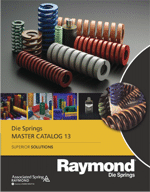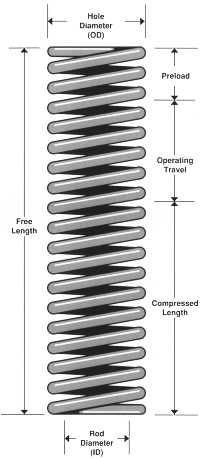Raymond Die Spring Catalog
 A general rule to observe in spring selection is to always use as many springs as the die will accommodate which will produce the required load with the least amount of deflection. This will increase the useful life of the spring, reduce the chances of spring failure and the resulting downtime, loss of production and increased maintenance cost.
A general rule to observe in spring selection is to always use as many springs as the die will accommodate which will produce the required load with the least amount of deflection. This will increase the useful life of the spring, reduce the chances of spring failure and the resulting downtime, loss of production and increased maintenance cost.
Die spring costs are a very small percentage of the total cost of the die. An effort to save a few cents on die springs is a misguided act that can cost many dollars in lost time and labor.
 The more rapidly a spring works, the more attention must be paid to its fatigue limits. In slow moving dies or fixtures, it is possible to get good performance with springs operating near maximum deflection. As the working speed increases, the life expectancy of the spring at that deflection decreases
The more rapidly a spring works, the more attention must be paid to its fatigue limits. In slow moving dies or fixtures, it is possible to get good performance with springs operating near maximum deflection. As the working speed increases, the life expectancy of the spring at that deflection decreases
Springs for strippers, pressure pads, and other die components can be selected from the Raymond Die Spring Catalog pages. When selecting a die spring it is necessary to determine the type of performance required of the springs: short, normal, or long run. For short or normal run applications use the deflections tabulated in the long life columns. For long run applications use deflections based on optimum life. The recommended deflections for each spring based on the performance required are shown on the Size, Deflection, and Load Charts (links are at the top of this page).
Another approach when selecting a spring is to work back from the amount of operating travel the springs will be subjected to as indicated by the die layout. Select springs in the appropriate duty range which will operate efficiently at the required travel. Calculate the number of springs needed by dividing the load supplied by one spring into the total load required. Round the total number of springs to the next higher even number for balanced performance.

